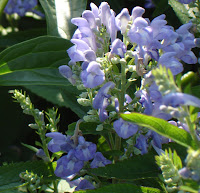
As you stroll through the garden today, your head will undoubtedly turn toward the stands of deep red
Hemerocallis 'Chicago Apache' (Daylily) in the Light Plate or to the many species of
Echinacea purpurea (Coneflower) in shades of pink, orange and greenish white. You might want to photograph the 4-foot tall, lavender blue
Perovskia 'Little Spire' (Russian Sage) mixed with bold, silvery
Eryngium yuccifolium (Rattlesnake Master). But if you take a closer look, you will find plants that are just beginning to open for their August showing.

In the Dark Plate, near the middle of the south path,
Scutellaria incana (Hoary Skullcap) is just beginning to show its lavender blue flowers on loosely branched 3-inch spikes. Another member of the mint family, this native makes soft mounds 3 feet high that will continue blooming into September. Small white hairs on its square stems give it the "hoary" description to its name. When dry, its seed head looks like a tiny helmet or skullcap. Directly behind this grouping is a subtle plant,
Salvia glutinosa (Sticky Sage). Its similar mound shape and pale yellow flowers make it a good companion for the skullcap.

At the top of the north stairs and overlooking the Seam,
Helelnium autumnale 'Rubinzwerg' (Sneezeweed) is opening its daisy-like flowers that are the color of roasted tomatoes with darker centers. This North American native is a member of the aster family and can grow to four feet. Its common name was given because its stamen parts were used as an ingredient in snuff, not because it was an allergen. Currently, two ornamental grasses are neighbors to the sneezeweed -
Sporobolis heterolepis 'Tara' (Prairie Dropseed) and
Molinia litoralis 'Transparent' (Moor Grass).
A dozen garden signs will be out identifying
Agastache 'Blue Fortune' (Giant Hyssop),
Liatris spicata (Blazing Star) and
Silphium laciniatum (Compass Plant) among others. Free tours are offered from 10 am to 1:30 pm and last about 20 minutes.
